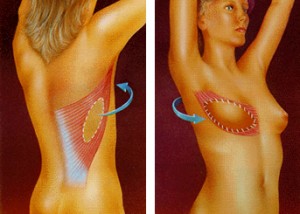 Numerous alternatives are available to women seeking breast reconstruction. Most commonly, patients are offered a simple technique, a tissue expander, or a complicated one, like a free-flap reconstruction (DIEP flap.) Often not mentioned, is an intermediate technique I call a "Skin-Sparing Latissimus Flap" which offers advantages over the other two procedures.
Numerous alternatives are available to women seeking breast reconstruction. Most commonly, patients are offered a simple technique, a tissue expander, or a complicated one, like a free-flap reconstruction (DIEP flap.) Often not mentioned, is an intermediate technique I call a "Skin-Sparing Latissimus Flap" which offers advantages over the other two procedures.
Traditionally, the latissimus muscle, which is a large, flat muscle on the back, was mostly offered as a breast reconstruction technique to patients who had failed previous attempts. Part of the reason for this was that the flap resulted in two types of deformity, one a long, vertical scar on the back and the second, a large patch of skin on the breast that did not match the surrounding skin in color. The picture in this section demonstrates these problems. Fortunately, over the years, numerous plastic surgeons have modified the latissimus flap so these deformities are now much less of a concern.
It makes sense that in an era of the "Skin-Sparing Mastectomy," where minimal skin is removed from the breast, the reconstructive procedure should also spare the skin. In a "Skin-Sparing Latissimus (SSL)," the incision is no longer vertical, which heals badly, but transverse, so that it will lie beneath the outline of a woman's bra. Additionally, since only a woman's nipple is missing, only a small piece of skin needs to be taken to replace it. This means the back scar is short and ideally, there is no mismatch of skin on the breast as the back skin is later tattooed to become the new areola.
What this means, is that the SSL procedure should be considered for all women undergoing mastectomies who are interested in breast reconstruction. The SSL has some clear advantages over a tissue expander reconstruction or a free-flap reconstruction. An SSL reconstruction frequently employs a tissue expander, but because it uses the patient's own tissue, the resultant breast usually feels much more normal than a breast reconstructed by an tissue expander alone. In contrast to a free-flap reconstruction, a SSL is much easier for the surgeon to perform and therefore has a much lower failure rate. While the SSL does involve more surgery than an expander alone and does require a breast implant, unlike a free-flap reconstruction, the SSL procedure may be the best choice for breast reconstruction for large number of women undergoing mastectomies.
To understand more about this procedure, go to: http://www.youtube.com/watch?v=3W9uUQRxkJg
Knowlton, E.W., Gorey, R., Taekman, H. "Total Immediate Breast Reconstruction with 'Peg' Latissimus Dorsi Flap." Contemp Surg. 41(3):15, 1992